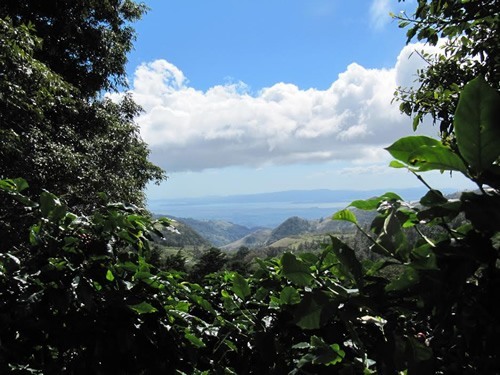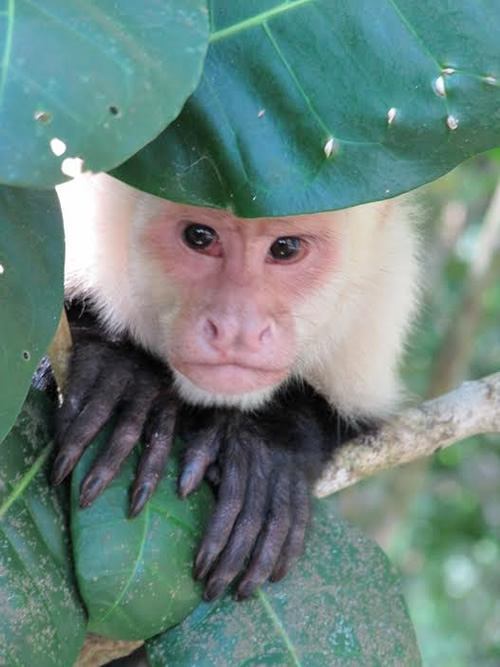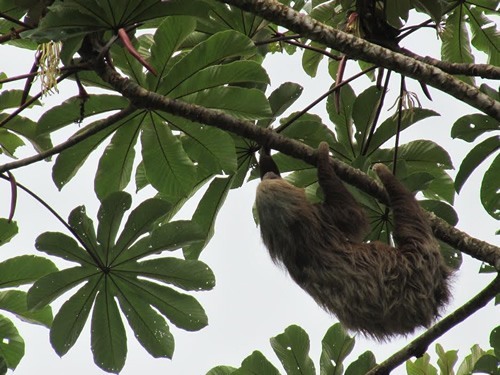Pura Vida Magic
in Costa Rica
Article and photos by Ellen
Girardeau Kempler
“The world is filled with magic
things, patiently waiting for our senses to grow sharper.” — W.B.
Yeats

|
|
View through Monteverde coffee
leaves to Costa Rica's Pacific Coast.
|
Three days into our family’s New Year trip to Costa Rica,
my neck ached. The pain wasn’t anything like the one that
radiated across my shoulders after a day hunched over my
laptop at home in California. This was more like the muscle
soreness you get after a workout. At first I blamed it on
sleeping in a hotel bed. Then, tipping my head back once
again to spot a bird, sloth, monkey, or butterfly, I realized
the animals were to blame.
The neck exercises started on the winding way from San Jose
to La Fortuna, when our group leader pointed out the first
howler monkeys in treetops along the road. Then, as the
bus pulled off beside a waterfall a few miles down, we saw
a coati, a long-snouted, southern relative of a raccoon,
begging for (illegally proffered) treats.
In between whitewater thrills on the Sarapiqui River, we
spotted Blue Morpho and Monarch butterflies, herons, egrets
and a macaw’s bright yellow breast. In the garden courtyard
of our funky La Fortuna cabinitas, we looked up,
down and around to spot wild residents, from what my husband
first called “giant squirrels” (actually, agoutis, relatives
of guinea pigs) on the lawn, to busy lines of leaf cutter
ants along the pathways, flamboyantly frilled iguanas nesting
in a palm tree and tiny brown frogs near the swimming pool.
The alternating rain and sun bred a kind of verdant exuberance
my drought-addled brain drank like fresh water. Grass worked
its way through sidewalks, sprouting in small jungles from
every crack and crevice. The air had a just-drenched smell
like moss, or mushrooms. Rainbows replicated themselves
in single, double and even triplicate from windblown mist.
The landscape itself seemed to be a continually multiplying
organism, exploding with unfamiliar color, sound, and movement.
In addition to spending time with my family and unplugging
completely from my laptop, I had come for the animals, especially
the monkeys. Our 9-day, budget adventure made the most of
the time we had, exposing us to three different environments:
Arenal Volcano, Monteverde Cloud Forest, and Manuel Antonio
National Park. I didn’t expect cultural immersion, but even
a short stay in Costa Rica imparts a sense of pura vida.

|
|
A curious white-faced Capuchin in Manuel.
|
Used interchangeably as a greeting, goodbye, and general
statement of goodwill, pura vida greases the wheels
of commerce and cultural diplomacy in Costa Rica, raising
the status of any tourist who embraces it. Popularized in
1956, after the release of a Mexican movie, Pura
Vida, the expression sums up its citizens’ pride in
living in a country that in 1948 chose
to disband its military and invest instead in security,
education, and culture. With a 96% literacy rate, an average
life span of 79 years and a solid democracy, Costa
Rica is the most progressive and stable country in Central
America.
When my husband pointed to the Costa Rican flag decal on
our river guide’s helmet and asked about the meaning of
the blue, white, and red stripes, he replied, “Cielo,
paz, sangre.” Those three words — sky, peace and blood — describe
a national identity enriched by nature, buoyed by peace,
and anchored by family: pura vida.
Above all, pura vida describes Costa Ricans’ (also
called Ticos) serene and reverent approach to their irreplaceable
natural landscape. The country’s 20,000-square-mile territory
is divided into 11
areas of conservation. 25% is protected
to varying degrees, and UNESCO counts it among the 20 most
biodiverse countries in the world.
This pura vida spirit touched me and
my youngest daughter as we walked up the road to the La
Fortuna Waterfall. A man renting horses waved us over. “Perezoso,
perezoso!” he exclaimed, pointing up at a nearby tree.
Cynically prepared to shake our heads and walk away at a
suspected sales pitch, we looked up and saw our first sloth,
close enough to see the moss growing on its back. Thanking
the man as he cracked a wide smile, we continued to watch
and snap photos of its progress up to tastier leaves, one
slow, outstretched arm after another, with many stops to
scratch along the way.

|
|
Slow Travel: Three-toed Sloth
near Arenal Falls.
|
Pura vida again prevailed on our tour
of a small, family-run sugar cane, coffee and chocolate
plantation, where we washed down a home-grown, home-cooked
meal of saucy chicken, gallo pinto (the national
dish, rice and black or red beans mixed together and mounded
high), homemade tortillas, fried plantains and water squash
(wild cucumber) with fresh-squeezed pineapple juice and
light-roast coffee (which, we learned, is actually the strongest).
When asked why the food here was so delicious, our guide
attributed it to a secret ingredient: love.
After skirting the edges of house-height stands of sugar
cane planted densely on hills overlooking the Pacific, we
stirred up a batch of molasses-like brown-sugar candy; tasted
chocolate; sampled sugar cane liquor; and rode in a traditional,
ox-drawn cart. Explaining the many stages of growing and
preparing each commodity, our guide called the process “slow,
like a sloth.”
Cultivating patience paid off when we arrived
in rainy, windy Monteverde. Disappointed by an earlier cloud
forest nature walk where humans were the dominant species,
we hired the same guide for a night hike through a private
wildlife preserve. Walking with flashlights on a dark, muddy,
route treacherously marred by potholes, rocks, roots and
branches, we set off with low expectations as he warned
us to stay on the trail or risk a deadly viper encounter.
Almost immediately, he started pointing out small, colorful,
sleeping warblers — still and unaffected by close observation — perched
like ornaments in trees along the trail. As we spotted silent
bird after bird (including one wide-awake toucan), I became
hyper-aware of my surroundings, alert to every new smell,
rustle and call.
Our guide pointed out insects: walking sticks
that blended into tree trunks and flat green ones that looked
like leaves. We watched bats flitting erratically and a
mottled owl that swiveled its head almost completely around
before swooping away. He pointed out landmarks: the spot
where another guide had once seen a mother puma and cub
and the tree where he’d often seen a kinkajou, also called
a honey bear. When we came to a small hole at the base of
a tree, he tapped inside with a stick. A palm-sized, orange-kneed
tarantula emerged and quickly scuttled back inside. Finding
a piece of wood nearby, he picked it up and asked us to
turn off our flashlights to see its fungi-covered surface
glow.
Throughout this sleight-of-hand, our guide’s radio crackled
and lights from another group bobbed nearby. Then the call
came, alerting him to a female two-toed sloth giving birth
in a tree. He could hardly contain his excitement as we
hustled down, practically running, to the spot. We arrived
in time to catch a glimpse of the newborn, hanging off the
branch near its mother, not yet latched on to her chest
for traveling. For ten minutes we stood watching as mother
and baby slowly moved to a less-exposed part of the birthing
tree. From our guide, we learned that sloths’ gestation
period is 11 months, and babies spend 2 years with their
mothers before going out on their own. The slow timetable
fits the species.
My eyes were opened. Stunned by what sat hidden
in plain sight along a dark trail, I knew I would never
think of the forest in the same way again. That’s why I
was ready a few days later, when I finally spotted my first
white-faced capuchin monkey peering out of mangroves at
Las Damas as we floated past in a flat-bottomed boat. “Monkey!”
I shouted, full of joy. It was already climbing down a vine
toward shore as the captain pulled up. We were soon face-to-face.
Only a week into 2015 and my life was complete. Pura
vida.
Ellen Girardeau Kempler is a writer who travels.
|
